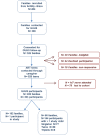Cohort profile: The Growing Up Healthy Study (GUHS)-A prospective and observational cohort study investigating the long-term health outcomes of offspring conceived after assisted reproductive technologies
- PMID: 35867723
- PMCID: PMC9307151
- DOI: 10.1371/journal.pone.0272064
Cohort profile: The Growing Up Healthy Study (GUHS)-A prospective and observational cohort study investigating the long-term health outcomes of offspring conceived after assisted reproductive technologies
Abstract
Worldwide, over 8 million children and adults are conceived following assisted reproductive technologies (ART), and their long-term health is of consequential public health interest. The objective of this paper is to describe the Growing up Healthy Study (GUHS) cohort in detail, publicise it and invite collaboration. Combining the data collected in the GUHS with other cohorts or databases will improve the much-needed knowledge about the effects of ART, and allow for better understanding of the long-term health outcomes of offspring conceived after ART. The GUHS cohort is a prospective observational study of adolescents and young adults conceived after assisted reproductive technologies (ART). It was established to determine if the long-term health of offspring conceived by ART differs from that of the general population. This was investigated by comparing a substantial number of health parameters to those of a representative population of offspring conceived without ART. The n = 303 GUHS participants were born between 1991-2001 in the two fertility clinics operating at the time in Perth, Western Australia, and undertook assessments at ages 14, 17 and 20, replicating the pre-defined study protocols from the reference cohort-the Raine Study. Participants were comprehensively phenotyped through detailed questionnaires, anthropometry, biochemical analyses, as well as age-specific assessments (asthma, atopy, cardiometabolic health, body composition, mental health, thyroid function, epigenetics and vision). To date the GUHS cohort has been used to study the methylation, cardiometabolic, and thyroid profiles, as well as respiratory and mental health. To summarise, the GUHS cohort provides a valuable addition to the limited knowledge of the long-term health outcomes of ART-conceived offspring.
Conflict of interest statement
RJH is the Medical Director of Fertility Specialists of Western Australia and a shareholder in Western IVF. He has received educational sponsorship from MSD, Merck-Serono and Ferring Pharmaceuticals. PB is the Scientific Director of Concept Fertility Centre, Subiaco, Western Australia. JLY is the Medical Director of PIVET Medical Centre, Perth, Western Australia. BPV and LAW have no competing interests to report. This does not alter our adherence to PLOS ONE policies on sharing data and materials.
Figures
Similar articles
-
Comparison of the cardiometabolic profiles of adolescents conceived through ART with those of a non-ART cohort.Hum Reprod. 2022 Jul 30;37(8):1880-1895. doi: 10.1093/humrep/deac122. Hum Reprod. 2022. PMID: 35640037 Free PMC article.
-
DNA methylation patterns within whole blood of adolescents born from assisted reproductive technology are not different from adolescents born from natural conception.Hum Reprod. 2021 Jun 18;36(7):2035-2049. doi: 10.1093/humrep/deab078. Hum Reprod. 2021. PMID: 33890633
-
Offspring conceived through ART have normal thyroid function in adolescence and as young adults.Hum Reprod. 2022 Jun 30;37(7):1572-1580. doi: 10.1093/humrep/deac095. Hum Reprod. 2022. PMID: 35526152 Free PMC article.
-
Study protocol for a Developmental Epidemiological Study of Children born through Reproductive Technologies (DESCRT).Hum Reprod Open. 2023 May 5;2023(2):hoad013. doi: 10.1093/hropen/hoad013. eCollection 2023. Hum Reprod Open. 2023. PMID: 37265937 Free PMC article. Review.
-
Clinical review of 24-35 year olds conceived with and without in vitro fertilization: study protocol.Reprod Health. 2017 Sep 20;14(1):117. doi: 10.1186/s12978-017-0377-3. Reprod Health. 2017. PMID: 28931409 Free PMC article. Review.
Cited by
-
The longer-term effects of IVF on offspring from childhood to adolescence.Front Reprod Health. 2022 Dec 8;4:1045762. doi: 10.3389/frph.2022.1045762. eCollection 2022. Front Reprod Health. 2022. PMID: 36570043 Free PMC article. Review.
-
Immune profiling of ART-conceived children in Kazakhstan: a case-control study.Front Pediatr. 2024 Nov 22;12:1447956. doi: 10.3389/fped.2024.1447956. eCollection 2024. Front Pediatr. 2024. PMID: 39649404 Free PMC article.
-
Focus on the endocrine system of children born after reproductive technologies in Kazakhstan.Qatar Med J. 2025 Jan 20;2025(1):9. doi: 10.5339/qmj.2025.9. eCollection 2025. Qatar Med J. 2025. PMID: 40370701 Free PMC article.
References
-
- Fauser BC. Towards the global coverage of a unified registry of IVF outcomes. Reprod Biomed Online. 2019. Feb;38(2):133–137. Available from: https://www.ncbi.nlm.nih.gov/pubmed/30593441 doi: 10.1016/j.rbmo.2018.12.001 - DOI - PubMed
-
- Newman JE, Fitzgerald O, Paul RC, Chambers GM. Assisted reproductive technology in Australia and New Zealand 2017. National Perinatal Epidemiology and Statistics Unit, the University of New South Wales Sydney. 2019.
-
- Hansen M, Kurinczuk JJ, Milne E, de Klerk N, Bower C. Assisted reproductive technology and birth defects: a systematic review and meta-analysis. Hum Reprod Update. 2013. Jul-Aug;19(4):330–53. Available from: https://www.ncbi.nlm.nih.gov/pubmed/23449641 doi: 10.1093/humupd/dmt006 - DOI - PubMed
-
- Kallen B, Finnstrom O, Nygren K, Olausson PO. Asthma in Swedish children conceived by in vitrofertilisation. Arch Dis Child. 2013. Feb;98(2):92–96. p. 92. Available from: https://www.ncbi.nlm.nih.gov/pubmed/23220203 doi: 10.1136/archdischild-2012-301822 - DOI - PubMed
Publication types
MeSH terms
LinkOut - more resources
Full Text Sources
Medical


